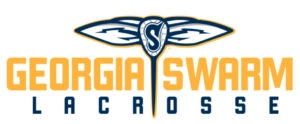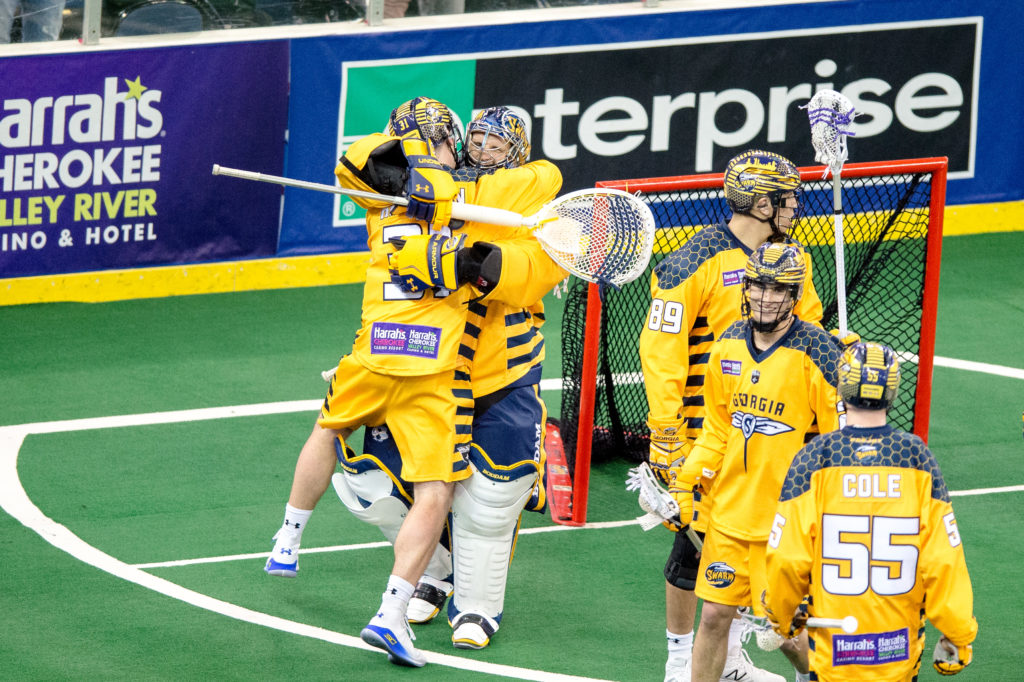With a win under its belt, the Georgia Swarm are ready to turn the page on 2017 and welcome 2018 with a visit from the 2-0 Saskatchewan Rush. The Rush made some big offseason moves before the 2017-18 season, but it comes to town relatively unchanged. This doesn’t mean Georgia gets to sleep easy against a team it beat three times in 2017. In fact, Saskatchewan’s first two games suggest otherwise.
The Rush came out with something to prove in its season opener, besting the Toronto Rock with a 17-9 victory. Then it invited the New England Black Wolves over a week later to Sasktel Centre before demolishing the pack 24-11. Saskatchewan got a bye week for Christmas and enjoyed ringing in the New Year rested. Now it travels to Georgia for its second road game of the season, first of 2018.
Georgia knows a win against the talented Rush won’t come easy. Yet the Swarm has momentum on its side now with its first win of the 2017-18 season and looks to stay on track as it tries to repeat as NLL World Champs. We’re in for a good game, but you and I need to do some prep work to fully appreciate what’s coming to town, so let’s start this Hive Five off with a review of…
Game 2 of the Champion’s Cup Finals
Just a few more seconds, and Sask would have forced a Game 3. Instead, Georgia pounced on the opportunity presented in the final seconds of regulation to force overtime in the craziest lacrosse play I have ever seen. No loss sits well with a team, and this one stung bad for the Rush, apparent by its offseason moves and…
New Rush Faces
If you look at Saskatchewan’s roster for its last game of 2017 (against New England on 12/23), it is noticeably very similar to what the Rush rolled out for most of last year. There are two big names that fill in two spots on the Rush’s Active Roster, and they are who we’ll be looking at for this Quick Sting.
Let’s start off on the big trade Sask pulled. The Rush traded goaltender Aaron Bold, defenseman John LaFontaine, the team’s first round selection in the 2017 NLL Draft, and a second-round pick in the 2018 NLL Draft for the 2016 NLL Goaltender of the Year Evan Kirk from New England. This blockbuster trade has been complimented by Sask’s first two games of the 2017-18 season. Kirk has two wins under his belt so far, having played in 120 min. and making 70 saves. He currently sports a 10.00 GAA and a .778 SV%. Against Georgia in 2017, Kirk went 1-2 with a no decision, sporting a 13.88 GAA and a .715 SV%.
The Rush traded lefty forward Adam Jones to the Toronto Rock for a first round pick in the 2018 Draft and another first rounder in the 2019 Draft, and Sask filled that forward position with Jeff Shattler. Shattler left Calgary as a free agent and joined an already dangerous Rush offense. The lefty out of Toronto has meshed well with Sask, having scored 11 points (3G, 8A) in two games. When he was with Calgary last season, Shattler did seven points (1G, 6A) worth of damage against the Swarm, the final game being held to just an assist.
Why are we spending so much time on these two players? Because you will probably be hearing their names a lot this weekend in addition to the usual Rush all-stars. Kirk immediately acclimated to the Rush defense, which was already one of the best in the sport. Shattler has done the same with the offense, clicked right in and went off to the races. He’s always been a consistently good player, but I remember being impressed at a whole different level when watching him in his first two games with the Rush.
Again, those defeats in 2017 prompted some work from the Rush. But sometimes it takes getting stung to right some wrongs. Look at Georgia. Two losses and a slow start to the Rochester game last Saturday, but it’s starting to look like the Swarm are…
Back to Their Swarming Ways
Saturday’s win was good because it started to feel like Georgia’s offense in 2017. Granted, that team averaged 14.77 GF/GAME, and the 2017-18 iteration scored under that with 14 GF Saturday, but Rochester’s defense is always a problem, so 14 GF against the Knighthawks is actually great.
Jesse King has been such a welcome return, leading the team in GF with eight, and they’re all creative and different. Lyle Thompson has warmed up and leads the team with 17 points (6G, 11A). Kiel Matisz, Shayne Jackson and Randy Staats are performing at their usual strong levels. What the offense was missing in the first two games, though, was diversity. Only five players found the back of the net for Georgia in the game against New England (Lyle 1, King 3, Jackson 2, Matisz 1, and Staats 4). That number ticked up against Colorado as seven different players scored against the Mammoth (Miles Thompson and Zed Williams each with 1 apiece along with everyone in the previous parentheses). Last Saturday, that number went to nine different players scoring a goal (John Ranagan, Bryan Cole, Jordan MacIntosh and Johnny Powless each with 1 apiece along with everyone in the first parentheses, swap Staats scoring for Miles (Staats may not have scored a goal, but he did record four assists on Saturday)).
Looking at the number of players who scored each game got me thinking: how did the Swarm do when a certain amount of players scored a goal? I kept using unselfish to describe last season’s offense, so let’s see if that is backed up with a diverse number of scorers per game:
5 – L, L, L
6 – W
7 – W, L, L, W, W
8 – W, W, W, W
9 – W, W
10 – W, W
11 – W
Over 18 games, Georgia had seven different players or less score goals in nine separate games and went 4-5 in those. Whenever eight or more players scored in a game, the Swarm was undefeated. This trend has continued over into this season. Georgia had five players score in the first game and lost, seven the second and lost, then nine last week and won. So for this relatively unchanged offense over 21 regular season games within a year’s time, it’s way better for the Swarm to feature diversity offensively. Seven players or less is a toss-up, but if eight or more different Swarm players find the back of the net, Georgia goes undefeated.
While the offense seems like it’s getting its feet back under it, can the same be said for the Swarm defense? Two losses to start the season is not the best showcase of a defense, so we should take a look at the numbers for…
The Swarm D Then and Now
Starting off, let’s get out of the way that Mitch Belisle retired, Ethan O’Connor is on the Holdout List and Chad Tutton is on the Injured List (Joel White doesn’t count for this Quick Sting since he didn’t play in a Swarm game last season until March). What they brought to the floor in terms of tangibles and intangibles is surely missed, but Georgia’s defense in 2017-18 features some key similarities to the 2017 defense through its first three games:
|
2017 |
2017-18 |
| GA |
33 |
38 |
| SOGA |
161 |
153 |
| PPGA |
9-20 |
2-6 |
| LB (Swarm-Opponents) |
207-214 |
190-200 |
From looking at these statistics, you see that the present Swarm defense is very similar to last season’s D. The numbers are a little down (up in terms of GA), but it averages out to under two GA more, under three SOGA less, and roughly 16.5 LB less over the three games on both ends. The big takeaway is how much better Georgia’s penalty killing is. In 2017, opponents were scoring on 45% of power play opportunities. This season, Georgia is more disciplined so far. In its first game, no player in blue and yellow committed a penalty. When the Swarm traveled to Colorado, it managed to kill all four penalties. Rochester was able to ruin Georgia’s perfect penalty kill numbers, but killing 66.67% of opponent power play opportunities is a sight better than only killing 55% of them. Add to the fact that the Swarm has only committed a third of the penalties, and that discipline is noticeably helping (2 GA > 9GA).
Plus, Georgia has rolled out three rookies on defense/transition each season. Connor Sellars, Bryan Cole and Sean Young were the three newcomers last season (plus offseason addition John Ranagan) and Brayden Hill, Zed Williams and Frank Brown rep rookies for the 2017-18 season (let’s not forget about Jerome Thompson moving from forward to transition and how his contributions on the defensive end have also helped). Georgia is very much in familiar territory right now.
Again, I know the Swarm has two losses to its name so far, and that alone is overshadowing how good the defense has been, especially compared with how it started last season during its championship run. And it has its biggest test yet coming in the form of a Saskatchewan Rush that is…
Hungry
I can’t think of a better adjective to describe the 2017-18 Saskatchewan Rush. Watching its first two games, the Rush just dominated on both ends of the floor. Mark Matthews, the runner-up for the 2017 NLL MVP, got banged up in Toronto and still looked hurt in the Rush’s second game of the season. He still scored 13 points (6G, 7A) against New England two weeks ago. Robert Church and Ben McIntosh are both torching opponents and sit at 14 points (5G, 9A) and 15 points (10G, 5A) respectively. I already went over how Shattler has melded to this dangerous offense and how Kirk has thrived with the Rush D in front of him. Two games into the season and Sask is posting a team 10 GAA. The Rush is scoring power play goals and killing penalties at a 66.67% rate. Sask is playing exceptional lacrosse and with an edge that’s just…man, it’s hungry. They want that Champion’s Cup and every game between here and there.
None of this is to alarm you, Swarm fan. Believe me when I say that hunger is the same in the Swarm locker room. All of this is to point out that Georgia has a tough opponent this Saturday, Jan. 6. And whatever the result, you will see a good game.


